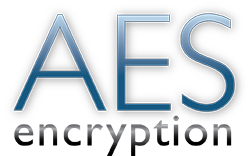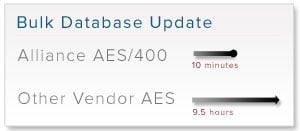AES Encryption Performance: Avoid the High Cost of Poorly Performing Encryption Solutions
 AES encryption has become the de facto standard for protecting data at rest in databases and unstructured data such as flat files, messages, EDI, and XML documents. As enterprises deploy data security solutions to meet compliance requirements, they are frequently surprised by the performance impacts of encryption. Inadequate attention to encryption performance can lead to increased costs, delayed or failed projects, compliance failure, reduced flexibility to meet competitive challenges, and exposure to legal liability.
AES encryption has become the de facto standard for protecting data at rest in databases and unstructured data such as flat files, messages, EDI, and XML documents. As enterprises deploy data security solutions to meet compliance requirements, they are frequently surprised by the performance impacts of encryption. Inadequate attention to encryption performance can lead to increased costs, delayed or failed projects, compliance failure, reduced flexibility to meet competitive challenges, and exposure to legal liability.
Whether you're evaluating an encryption solution or already encrypting data, these tips about encryption and performance will help ensure you have the right solution in place.
Encryption - A Resource Hungry Application
By its very nature, encryption and decryption are resource intensive processes. Encrypting a simple credit card number requires many thousands of computer instructions. These instructions merge the input data with an encryption key using a large number of computer instructions to produce the secured data (called the “cipher text”). Because of the large number of computer instructions, an enterprise customer will experience increased utilization of computer resources and a need to consider adding additional capacity.
Ask for performance metrics
Armed with the knowledge that encryption performance is important, you can take action to avoid potential problems. Before acquiring an encryption solution, ask your data security vendor to provide performance metrics for their solution. How long does it take to encrypt one million credit card numbers? Can they provide you with source code and demonstrate this performance on your server?
The Hidden Costs of Encryption
Poorly performing encryption solutions can come with steep price tags as you secure more data in more places. You may have to add additional memory and increase the number of processors to handle the demands of encryption. As you upgrade your server hardware, the operating system vendor and application software vendors may increase the license fees they charge for their software. These cost increases may ripple through your backup and high availability systems. On top of increased hardware and software, your human resource costs also increase as you deploy larger and more powerful servers.
Are Network Encryption Devices a Good Idea?
Some security vendors provide encryption solutions on an external server as an encryption appliance. Each time your application needs to encrypt or decrypt data, a connection to the server is created and the data is transferred to the server for the encryption operation. Be sure to understand the maximum encryption rate of these types of appliances when doing a large number of operations. if it takes 5 milliseconds to transfer data to a server for encryption,
and 5 milliseconds to return the encrypted data, that 10 milliseconds can represent a performance problem.
Test Drive - not all AES encryption solutions are the same
Townsend Security's proven AES encryption solution encrypts data 94x times faster than the competition. Request a free 30-day trial of our popular Alliance AES Encryption and see for yourself.
But don't just take our word for it, read what Staples has to say about their experience with our AES encpryption solution.
Case Study A large multi-brand retailer, that sells its products online and in traditional retail outlets needed to meet PCI Data Security Standards for protecting customer credit card information. After evaluating several different vendors for performance they decided on AES Encryption from Townsend Security. They deployed the Alliance AES/400 Encryption solution to protect sensitive data in DB2 database files and in a variety of unstructured data files and were able to achieve PCI compliance in record time.
A large multi-brand retailer, that sells its products online and in traditional retail outlets needed to meet PCI Data Security Standards for protecting customer credit card information. After evaluating several different vendors for performance they decided on AES Encryption from Townsend Security. They deployed the Alliance AES/400 Encryption solution to protect sensitive data in DB2 database files and in a variety of unstructured data files and were able to achieve PCI compliance in record time.
Townsend Security Can Help
The best way to secure sensitive information is with strong encryption and key management. Townsend Security provides NIST validated encryption and logging solutions for the enterprise. Our encryption, key management, tokenization, and logging solutions protect sensitive data from loss, whether it is at rest or in motion. With NIST validated and FIPS 140-2 compliant certified solutions, Townsend Security meets or exceeds the standards in PCI, HIPAA/HITECH, and state privacy laws. Click here to download a free 30-day trial of our popular Alliance AES Encryption.



 Now that the new version of the PCI Data Security Standard (PCI DSS version 2.0) is in effect, many IBM i (AS/400, iSeries) customers are getting dinged on their PCI compliance in the area of encryption key management. The renewed focus on "Dual Control" and "Separation of Duties" by QSA auditors is forcing many IBM i customers to move from homegrown key management to a better method of securing keys. This is even happening for IBM i customers who use IBM’s Master Key and key database facility. Why is this? There is just no way to properly implement effective security controls for the QSECOFR user, or for any user with All Object (*ALLOBJ) authority. Thus no "Dual Control" and no "Separation of Duties." And QSA auditors have figured this out.
Now that the new version of the PCI Data Security Standard (PCI DSS version 2.0) is in effect, many IBM i (AS/400, iSeries) customers are getting dinged on their PCI compliance in the area of encryption key management. The renewed focus on "Dual Control" and "Separation of Duties" by QSA auditors is forcing many IBM i customers to move from homegrown key management to a better method of securing keys. This is even happening for IBM i customers who use IBM’s Master Key and key database facility. Why is this? There is just no way to properly implement effective security controls for the QSECOFR user, or for any user with All Object (*ALLOBJ) authority. Thus no "Dual Control" and no "Separation of Duties." And QSA auditors have figured this out. I just listened to a discussion of database security hosted by Oracle that was very well done. At one point the discussion turned to current threats and how the Enterprise has lost the ability to use perimeter protection for sensitive data. This has been a topic of much discussion in the security area for the last few months. Perimeter protection is based on the use of Firewall and similar technologies to keep the bad guys out, but this approach is failing with the advance of more sophisticated attacks, the use of social media by large organizations, the advance of mobile technologies, insider threats, and the migration of applications to cloud platforms. The trend is called “de-perimeterization” and represents a bit of a challenge to organizations that need to protect sensitive data.
I just listened to a discussion of database security hosted by Oracle that was very well done. At one point the discussion turned to current threats and how the Enterprise has lost the ability to use perimeter protection for sensitive data. This has been a topic of much discussion in the security area for the last few months. Perimeter protection is based on the use of Firewall and similar technologies to keep the bad guys out, but this approach is failing with the advance of more sophisticated attacks, the use of social media by large organizations, the advance of mobile technologies, insider threats, and the migration of applications to cloud platforms. The trend is called “de-perimeterization” and represents a bit of a challenge to organizations that need to protect sensitive data. I just returned from a trip to Europe and Encryption Key Management was a very hot topic. This is a topic I very much like to speak about, given our recent release of
I just returned from a trip to Europe and Encryption Key Management was a very hot topic. This is a topic I very much like to speak about, given our recent release of